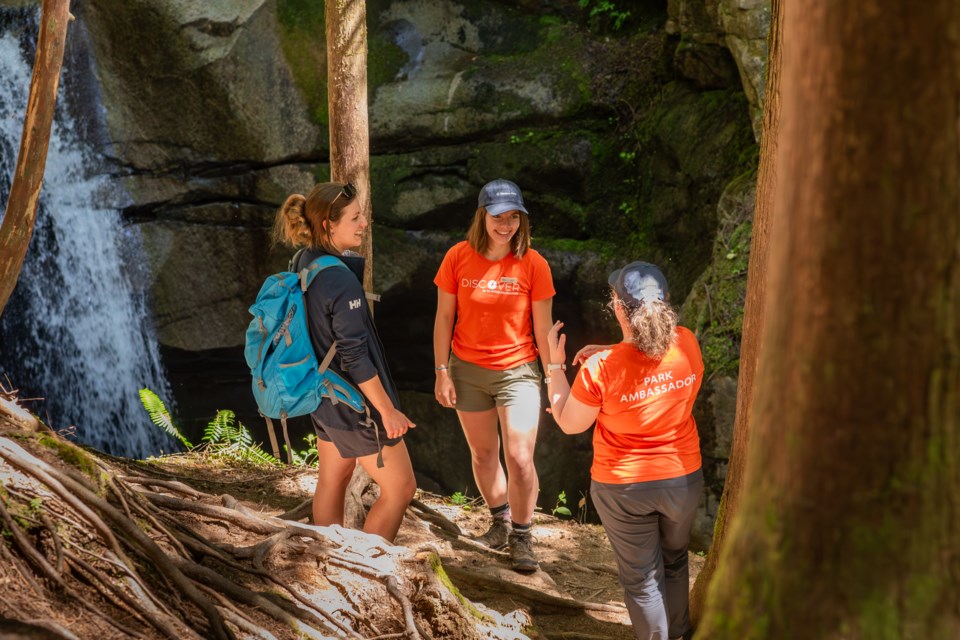For years, visitors to parks around B.C. were greeted by interpretive programs like Jerry’s Rangers. These programs taught environmental stewardship through fun, hands-on activities like wildlife tracking, ecosystem games and nature-based storytelling.
But in the 1990s, funding dried up, and programs like Jerry’s Rangers were shuttered across the province.
“B.C. became one of the only park jurisdictions in North America with no interpretive services,” recalled Andrew Day, CEO of BC Parks Foundation.
The Parks Foundation—BC Parks’ independent charitable arm—launched in 2018. One of its key goals was to bring interpretive programming to the province.
“We know that when those kinds of services are available, that people come back more often and if they've come from afar, they stay longer,” Day told Pique. “So it's super beneficial for tourism to the area, but it also is just really fundamental to building a culture of long-term stewardship of the parks.”
The Foundation relaunched interpretive programming in 2020 with the Discover Parks Ambassadors (DPA) program. The ambassadors run educational programming for park visitors, including guided nature walks, family-friendly games and activities and interpretive presentations. And they also brought back Jerry’s Rangers.
The program started in just five parks. But this summer, .
Over the last five years, those fundamental roles of the DPAs hasn’t changed.
However, Day said the breadth of tasks the ambassadors now undertake has widened. In addition to kids’ programming, they’ve also become part of a larger contingent of citizen scientists, collecting data on more than 80 threatened species and contributing upwards of 13,000 unique biodiversity reports through the iNaturalist app to support ecological research.
In some parks, like Wells Gray, the ambassadors have a trail team that works on building up and maintaining the network of trails that let visitors explore the park.
Fortunately, the kind of person who takes on an Ambassador role is up to the multi-faceted challenge. Day can’t say enough about the team.
“If you have any doubts about young people these days, you’ve got to meet [the ambassadors],” said Day. “These are incredibly enthusiastic, positive, intelligent, organized individuals, and they pass their passion for nature, for finding different species, for parks along to visitors.”
Parks for everyone
Day is also proud of how the ambassadors have opened up parks to include more populations.
As of January, thanks to a partnership with the Island Deaf and Hard of Hearing Centre, has been brought to five trails in the form of self-guided nature walks, park tours and even a sunset photography lesson.
The Foundation has also worked with Immigrant Services to welcome groups of refugees to parks. Day said they’ve received feedback that it helps address a sense of isolation that newcomers can feel.
“Newcomers get here and they see that our identity in B.C. is really tied closely to parks and nature,” said Day. “So they come to the parks, they meet people, and they just have this sense of being welcomed in and connected to what's important about being here and the culture and identity of living in B.C.
“I've been pleasantly surprised at just how meaningful these experiences are to people, how much positive feedback that we've gotten,” he added.
Day anticipates the DPA program will continue to grow to encompass more parks. The key challenge, however, is funding. The ambassador program is largely donor-funded, so incorporating the rest of the province’s 600 parks remains a challenge.
He’s also aware of discussions about whether parks have an upper limit when it comes to annual visitors. Case in point, both to allow Lil’wat and N’Quatqua Nations to carry out traditional practices on their unceded land and to allow the environment to heal from a barrage of tourists.
“With the Sea to Sky, we know there’s been some controversy about [whether] it’s being loved to death,” Day said.
In response, the Foundation, in partnership with Sea to Sky Gondola, . The Fund is a partnership between the Foundation and local businesses. Money raised goes towards building up infrastructure—from improving trails and docks, to building bridges and making parks more accessible, to installing public amenities like toilets.
Day sees those rolling upgrades to the network of parks as being key to balancing the demands of exploring the unique beauty of the province and protecting sensitive environments.
“I think saying, ‘There's too many people getting outside’ is probably not right,” said Day. “There's just too many benefits; it's good for tourism, businesses and communities.
“So, if we want to continue to have access to this incredible place, and all the benefits of that, then having these kinds of guided experiences in the form of ambassadors and then complementing that with the proper infrastructure, is really the path forward.”
The Ambassadors are part of a wider array of programming under the Discover Parks initiative. To learn more about the DPA, Discovery Centres and self-guided Discover Trails, visit .


